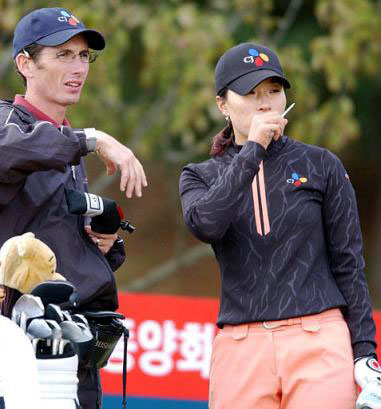 |
 |
 |
 |
 |
 |
Se Ri Makes History
People in South Korea have gotten used to Se Ri Pak. They pretty much expect, week after week, year after year, that she will be in contention, that she will shoot amazing scores, that she will win a bunch of times. I suppose it's easy for them to get jaded, or for the expectations to weigh her down. Yawn... another win for Se Ri, the 'Golf Queen', as they have nicknamed her there.
But even the 'seen it all' Korean fans knew something quite different was going to happen the week of October 20th. For that week, Se Ri was going to play, for the first time, in a men's event. The event in question was the SBS Super Championship on the Korean PGA tour. The course, Lakeside Country Club, is renowned in Korea as one of the more impressive tracks you can play there. Se Ri was the only woman in a field of 126 players. The press was abuzz with anticipation: could she make the cut? Could she contend? Could she WIN? The fun part was, no one knew, not even Se Ri. It was a new frontier she was tackling, and the results were bound to cause discussion, no matter what happened.

Se Ri and Colin prepare for the SBS
Championship
AP Photo/Yun Jai-hyong
Before we continue, let me go on record to say that generally, I am opposed
to women playing in men's events. But not for the reason that they 'don't
belong there', or that they are 'taking a spot from a male pro', or even
that 'it's unfair, because they didn't have to qualify'. Sponsor's exemptions
are just that: sponsor's exemptions. These are not spots that would otherwise
go to deserving pros; they are spots reserved for the sole purpose of
inserting someone not otherwise qualified into the field. If the
sponsor wants to put a woman into a field (and there is no rule against
it), I say more power to them. And there are plenty of male pros who got
their start playing in tournaments via sponsor's exemptions, so if you
are going to object to women doing it, why not object to men doing it?
And I would much rather see a truly great player like Se Ri Pak playing
the men than an unformed prodigy like Michelle Wie or a club pro like
Suzy Whaley. With Se Ri, the buzz is still there, because you know she
is capable of almost anything, just like when Annika Sorenstam played
Colonial.
No, the reason I object to women playing men's events is that it somehow
suggests that it is not good enough to play just women's events. That
the only way a woman can prove her talent is by teeing it up against the
men. Which is, of course, absurd. But then the mostly male media quietly
support that notion, whether they intend to or not, by giving overwhelming
coverage to women only when they play against the men. I've seen numerous
'year of the women' proclamations by the golf press. Almost inevitably,
what they mean is 'year of women playing against men', for they focus
not on newsworthy items like Se Ri Pak's three wins, Grace Park's or Hee-Won
Han's or Candie Kung's emergence, Hilary Lunke winning the US Open, or
the Solheim Cup. No, the focus is always 'Annika, then Wie, then Whaley'.
And those three have exactly one thing in common: that they have played
against men this year. Yet sportswriters do not force the Sugar Bowl Champion
to play the Super Bowl champion to 'legitimize' the college football champion.
Nor do they force Duke or Kansas or UConn to play the Lakers to prove
that the NCAA basketball powerhouses are legitimate. It's an unfortunate
double standard, and until such time as people start to come into the
media who respect women's sports more, we'll just have to live with it.
Se Ri Pak, I suspect, had simple motives for doing this. Namely, she saw
how, right after playing Colonial in May, Annika Sorenstam was a different
golfer, particularly in the Majors. Suddenly, this woman, who had never
had a particularly stellar record in the Majors, won two Majors in a year
for the first time in her career. Se Ri doubtless presumed that practicing
to play from the men's tees had helped Annika, and believed it would help
take her game to the next level as well. And if a good performance in
the SBS Super Tournament led to an invite to a PGA event, well... how
could that hurt her? And perhaps it would also get her a little piece
of the hype that has eluded her for years, despite a record of unmatched
brilliance for one so young.
From the minute Se Ri arrived in Korea, she was in the middle of a media storm even more intense than usual. Reporters were constantly peppering her with questions about the course, her preparations, how she thought she would do. She arrived at the course a few days early, and played a nine hole practice round surrounded by reporters. The reporters noted excitedly that, on the par 5 1st hole, a downhill hole of about 580 yards, that Se Ri hit a monster drive of (reports varied) 320 or 330 yards. The story made the national news, and we watched as Se Ri negotiated a chip shot into the hole from 70 feet, or hit a bunker shot to two feet for a par save. Se Ri's assessment was perhaps an omen. She said that she was surprised how little distance had affected her play. On only one hole was she forced to hit more than a 7 iron approach, that being a five iron second on a long par 4 on the front side. Although the course was 7,050 yards long, 500 yards longer than any course she had ever played in a tournament before, she was confident that she would be able to make the cut, which was her primary goal.

Se Ri during her practice round
AP Photo/Yun Jai-hyong

More practice for Se Ri
Later, Se Ri would confess that the first two rounds of this tournament, where she would have to play well to make the cut, were the most pressure packed of her career. The media was setting it up so that they all but expected her to make the cut; a missed cut, especially one where she didn't even come close to making it, would be a major disappointment. She had no room to miss the cut by four shots like Annika had done at Colonial. If Se Ri did not make the cut, it would not be viewed favorably in the Korean press, and she knew it.